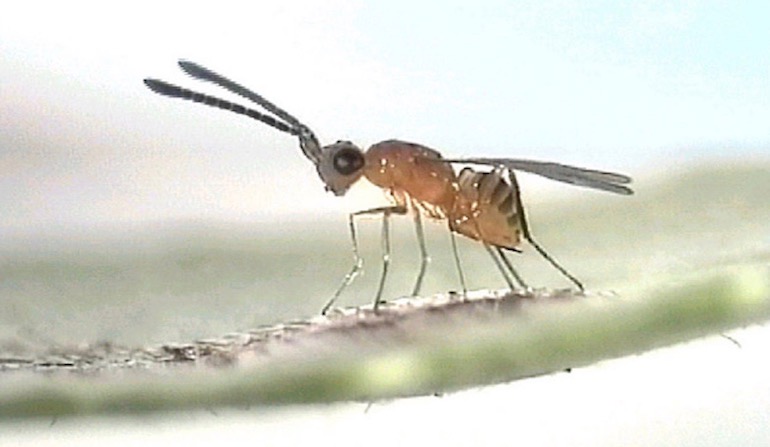 Intelligent Design
Intelligent Design
Gecko, Fairyfly, Manta Ray: Animals Push the Limits of the Possible


If humans cannot yet achieve these feats with our best engineering knowledge, what are we to think of humble animals that make the semi-miraculous look routine?
The Gecko
A favorite animal for bio-inspired science, the gecko has earned more claims to fame beyond its ability to walk on walls and ceilings. (That trick, you remember, relies on a property of adhesion at the atomic level called the van der Waals force.) Yes, robot designers would love to imitate that feat. And think of the wannabee spider-kids that would be thrilled to open a holiday present to find a costume that would let them walk up walls like Spider Man. Fabrics with microscopic hairs imitating the gecko footpads might just make that possible someday (to the horror of moms).
But adhesion is not the only trick for these lizards popularized in car insurance commercials. Geckos can also walk on water! Believe it or not, geckos are among the few animals (including basilisk lizards and grebes) that can skitter across the surface of water without sinking. Scientists at the University of Oxford filmed them in slow motion to see how they do it.
Watch the video from The Conversation, where Jasmine Nirody from the Rockefeller University in New York describes how her team figured out the unique way geckos solve this problem.
Initial calculations hinted, and video analysis confirmed, that unlike other species that move at the water’s surface, geckos use a combination of techniques to move faster on top of the water than they can by swimming through it. By analysing videos of geckos moving across the water, we found that their gait was similar to that of the basilisk. Each step involves retracting the foot through the air, slapping the surface, and stroking beneath the water.
But unlike basilisks, which aren’t affected by changes in the water’s surface tension, our experiments showed that geckos’ speed and head height were cut by half when we added detergent to the water, reducing the surface tension. This suggests that they are at least partly using the forces between the water molecules to stay above the surface. [Emphasis added.]
Who taught the gecko atomic theory? Nirody goes on to describe how they perform “semi-planing” by combining hydrostatic forces with hydrodynamic forces. Having superhydrophic skin helps, too. In addition, the gecko’s tail undulates from side to side during the run to stabilize the lizard and add propulsion, letting it keep 72 percent of its body above water and reach speeds of 3 feet per second.
Our research shows that for medium-sized animals to move quickly along the surface of water a complex and clever combination of physical mechanisms is required that previously was thought only to occur in larger and smaller animals. But it could also feed into better designs for animal-inspired robots.
The research was published in Current Biology. You will enjoy a video from Berkeley News, “The Gecko: Nature’s Superhero.”
The two-minute clip shows several “superpowers” of the gecko beyond climbing walls and walking on water. Geckos are shown gliding through the air, landing upright like a cat, and inverting under objects while running at full speed. Show this video to your kids — that is, if you are prepared to have to buy a gecko for the holidays to satisfy their pleadings afterward. Indulge their curiosity about animals with superpowers while you can, because it might inspire them to become design scientists.
The Fairyfly
How small could you make a flying animal? The fairyfly is so tiny, it matches the cross section of a human hair! It’s hard to believe you can pack enough cells in this insect (not a fly, but a kind of wasp). Wingless varieties average 0.139 mm in length. Tinkerbella nana, at 0.16 mm, sets the record for smallest flying insect, according to a “Quick Guide” in Current Biology. How do they get so small? For one thing, their cells are smaller than normal, and everything is downsized to the extreme.
The minimum body size in insects is limited by physical, physiological and structural constraints, including lower limits on egg size, the axon diameter of neurons, and the size of the central nervous system. For example, if the axon diameter of a neuron is less than 0.1 micrometers, it would be nearly impossible for it to relay information because of the high level of noise from sporadic ion-channel activity. Similarly, sensory units such as the ommatidia of an insect’s compound eye have a lower limit on their size because, with lenses below this limit, the wave nature of light causes a type of image blurring called diffraction. The constraints of diffraction-limitation and space available on their head mean that the fairyflies have as few as 20 ommatidia and with size of the lens close to the diffraction limit. As a result, their vision may be restricted to tasks that do not require spatial detail, and their activity is likely to be diurnal.
A diagram shows a fairyfly at comparable size to a paramecium, a one-celled animal. This is astonishing! How can this insect have enough space to pack organs and tissues, let alone wings?
The miniature fairyflies do have working digestive, reproductive, nervous, circulatory and respiratory systems, but their relative sizes are different from their bigger ancestors: their digestive system, circulatory system and musculature are relatively small, and their central nervous system and reproductive system are relatively large.
They have working olfactory systems, too — and brains to operate their senses and organ systems. But when it comes to flight, things get really close to the limit of the possible:
Fairyfly wings are not only small, but their structure is comb-like and made of several bristles instead of a planar sheet. Their very small size means that the air around them is more viscous than it would be for larger insects. At such small scale, the ratio of inertia to viscosity, the Reynolds number, is so low that any movement provided to an air packet quickly dampens out. It also means that a single wing bristle drags along with it a boundary layer of a comparable size. Thus, if the bristles are sufficiently close, the comb-like wing can act as a paddle to generate the requisite aerodynamic forces, while reducing the overall mass of the wing.
The flapping motion is also specialized. Their wings collide on the top flap, enhancing aerodynamic forces in a process called “clap and fling.” So little is known about the lives and habits of these miniature flyers, they opens many doors for design studies. The authors say:
The unique biology of the miniature fairyflies offers many exciting avenues for biological research. Despite their miniature size, in many ways fairyflies function similarly to bigger wasps, but their size raises many interesting questions. How does being miniature affect their neural circuits? Are the miniature brains more energy efficient in information processing? If so, can we build efficient computational procedures inspired by their tiny brain? What are their cognitive abilities and how do they learn and remember?
The Manta Ray
You’ve heard of filter-feeders: whales, sea anemones, and many other marine organisms need to grab solids out of the water to eat. We humans, too, require filters in our coffee makers, swimming pools, and cars. “Solid-liquid filtration is a ubiquitous process found in industrial and biological systems,” say Divi et al in Science Advances. They describe four known mechanisms for filtration, and then, to their surprise, find that the manta ray has a different mechanism for gathering plankton from seawater that is very effective:
Although implementations vary widely, almost all filtration systems are based on a small set of fundamental separation mechanisms, including sieve, cross-flow, hydrosol, and cyclonic separation. Anatomical studies showed that manta rays have a highly specialized filter-feeding apparatus that does not resemble previously described filtration systems. We examined the fluid flow around the manta filter-feeding apparatus using a combination of physical modeling and computational fluid dynamics. Our results indicate that manta rays use a unique solid-fluid separation mechanism in which direct interception of particles with wing-like structures causes particles to “ricochet” away from the filter pores. This filtration mechanism separates particles smaller than the pore size, allows high flow rates, and resists clogging.
The authors envision “interesting industrial applications” for “this unique solid-fluid separation mechanism, which we have termed ricochet separation.”
That’s all for now, but with millions of species of animals out there, all suited for their environment with ingenious mechanisms at the limit of physical possibilities, we don’t expect to run out of similar material soon.
Photo: A fairyfly (Gonatocerus triguttatus), by Reyes Garcia III [Public domain], via Wikimedia Commons.

